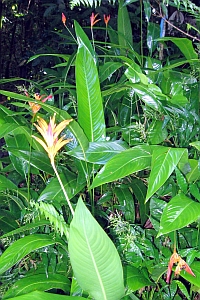Researchers from the U.S. Joint BioEnergy Institute (JBEI) of the Department of Energy have isolated a tropical microbe that can endure high concentrations of ionic liquids, the solvents used to process cellulosic biomass into economical commercial biofuels. The team led by the institute’s Michael Thelen reported its findings this week online in the journal Proceedings of the National Academy of Sciences.
Cellulosic biomass — feedstocks for biofuels from non-food sources, such as prairie grasses and agricultural residues — first needs to be treated to remove woody material called lignin, where the energy-producing complex polysaccharide sugars reside. This pre-treatment step uses ionic liquids, environmentally benign organic salts that substitute for more harmful volatile organic solvents.
JBEI researchers have already engineered a strain of E. coli bacteria to digest the cellulosic biomass of switchgrass, one type of prairie grass suitable for biofuels. However, the ionic liquids used to pre-treat switchgrass were toxic to the engineered E. coli. As a result, multiple pre-treatment steps were needed to wash out the ionic liquids before introducing the bacteria.
To break this cycle, microbiologist and paper co-author Kristen DeAngelis found a strain of the microbe Enterobacter lignolyticus in the El Yunque National Forest in Puerto Rico. In El Yunque, microbial communities have displayed high rates of biomass decomposition, and a tolerance to the pressures like those generated from exposure to ionic liquids.
Thelen’s team discovered that the particular strain of Enterobacter lignolyticus was able to grow in ionic liquids with concentrations comparable to those that remain from commercial pretreatment and recovery steps. This finding alone could reduce the number of processing steps and bring biofuels closer to a more economical “one-pot” strategy for processing cellulosic feedstocks.
At least as important as the discovery of the capabilities of Enterobacter lignolyticus, was the greater understanding it revealed of the way this microbe is able to tolerate the ionic solvents. The team developed a model for ionic liquid tolerance that Thelen says suggests the microbe can resist the toxic effects by “altering the permeability of their cell membrane and pumping the toxic chemical out of the cell before damage occurs.” These mechanisms were known, says Thelen, but not in coordinated manner shown in the study.
The study’s findings will help engineer new microbes for biofuel production that can tolerate ionic pre-treatments. The results can also be used to study biological responses for other needs, such as screening chemical compounds to develop medications.
The Joint BioEnergy Institute is a multi-institutional partnership led by the Lawrence Berkeley National Lab in California. Team members included researchers from the Berkeley Lab, Lawrence Livermore National Lab, Sandia National Lab, and DoE’s Joint Genome Institute.
Read more:
- Bacterial Process Converts Recycled Newspapers to Biofuel
- Bacteria Metabolism Reversed to Produce High-Speed Biofuel
- E. Coli Engineered to Produce High-Volume Biofuel
* * *


 RSS - Posts
RSS - Posts
You must be logged in to post a comment.